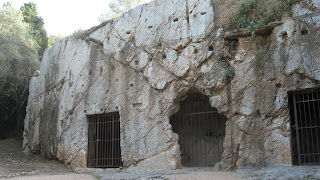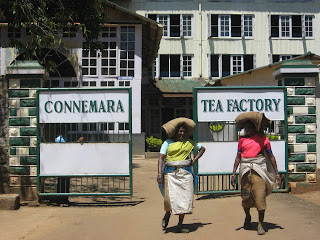Today I uploaded pics below the blog so keep scrolling down after you read. I made a mistake - obviously, King Minos' throne is against the wall on the right (not the left) of the picture below!
YASAS! This is the greeting word in Greece every where we go (but I don't know how to spell it). I am studying the Greek alphabet (never too late) and I have the capitals down, but many lower case letters don't even look like the upper case letters!
The sun has risen on Agia Galini on the southern coast of Crete. It is an old town, perched on a hill that descends rapidly to the Libyan Sea. The town is quiet at this hour of the morning, except for the birds and the goats. Our tiny balcony faces a steep hillside rather than the sea, and so we have a good view of the activities of a small herd of goats.First, they were on the vertical hillside then they jumped onto the flat roof of the neighbors across the street.
Greece really is WHITE AND BLUE!! All the houses are white with blue doors and windows. Words fail me when I try to describe the blues of the waters around these islands. They are crystal clear! Which leads me to comment on how CLEAN Greece is. No old plastic bags in the water or on the streets!
YAMAS! After our first meal in a Cretan restaurant, we asked for the bill and they brought us shots of ouzo and plates of sweets. The guide book warned that Greek waiters bring food you did not ask for, so we were wary (but we drank the ouzo and ate the cake). Now that we have been in Greece for two weeks we have discovered it is standard for restaurants to give you after-dinner treats on the house. Usually when the waiter brings the ouzo, he says something like "medicine!" or "vitamin!" And we raise our tiny glasses and say YAMAS!
The most extreme example of this hospitality was last week in Frangokastelo (see fortress below). We stayed and often ate at the Artemis Taverna. When we first arrived, the host brought ouzo for a toast between us and himself. After our first breakfast, he also brought us ouzo! Another time, when he brought ouzo before we even ordered our food, I asked him WHEN one drinks ouzo, before or after the meal? He replied, "Before and after!" and duly brought us another set of ouzo glasses (and his to toast with us) when we were done.
Frangokastelo isn't even a town - it is a series of houses and tavernas surrounding the remnants of the 13th century Venetian fortress you see in the pics below. You can find reference to it in wikipedia and on youtube because of the Drossoulites, the ghosts of Greek rebels massacred on May 18, 1829. Every May, they march at dawn across the coastal plain and disappear into the sea near the fort. We arrived on May 17th and enjoyed the rise of a dramatic full moon over the castle next door. They say the occupying Germans in WWII actually fired at the Droussoulites, but none of the residents we spoke with had ever seen them. I got up at 5 am every day to see the Drousolites - to no avail.
Our other main activity in Frangokastelo was vitamin D synthesis - lying on the lovely deserted beach for 2-3 hrs. We are very toasty looking now. The water was very shallow, few waves. Tourist buses would stop around lunch time to visit the fort and walk on the beach and eat lunch but by 3 pm it was virtually ours again.
One night, (Saturday May 21st) shots were fired around midnight. It was the feast day for everyone named Kostantinos. We knew about the feast day because earlier that day we had gone next door to the Kali Kardia restaurant for some typical Greek food: spinach pie, gigantic white beans in a tomato sauce, and a Cretan salad (cuke, tomato, hard boiled egg, potato, croutons made from rusks of whole wheat Cretan bread, small green olives,green pepper, LOTS of feta cheese,dressed with olive oil). Before we left, the owner insisted we share our obligatory ouzo with his uncle, Kostantinos, who was celebrating his feast day. Kostantinos had spent 40 years in NYC making pizza. We drank to his health, the health of his children, Greece, America, etc. We learned his adult children and wife were still in NYC and he would be attending his daughter's wedding there soon.
The next day there were quite a few cars in front of the Kali Kardia. We thought - yeah, everyone knows they have the best cook in town! We went inside for breakfast. It was apparent that Kostantino's feast day party went long and late as a long banquet table still had dirty cups and napkins on it. People stared at us with glazed eyes - the owner was a bit tongue tied - I figured it was all that ouzo from the night before. When we asked if we could have breakfast, he looked at us intently and blurted out - "Last night we had a terrible accident." In broken English laden with grief he explained - his uncle, Kostantinos, whose health we toasted the day before, had fallen down the marble steps and hit his head. I asked if he was OK now, and he said, "No, he died." The worse part of it was that no one realized it! They had just found him a little while before we arrived at the bottom of the stairs, lying on the Taverna patio covered with grapevines that looks out on the sea. They were waiting for the police, the coroner, the priest, etc.
We barely knew him, but we were strongly affected. How unpredictable life is! I always think of John Lennon's line, "Life is what happens to you while you are busy making other plans." So, CARPE DIEM, folks!!

















































